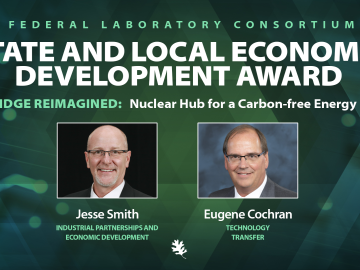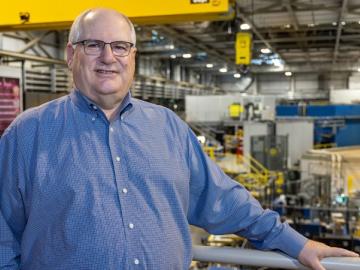
Filter News
Area of Research
- (-) National Security (58)
- (-) Neutron Science (123)
- (-) Nuclear Science and Technology (25)
- Advanced Manufacturing (6)
- Biological Systems (1)
- Biology and Environment (42)
- Computational Biology (2)
- Computational Engineering (2)
- Computer Science (7)
- Electricity and Smart Grid (3)
- Energy Science (80)
- Fuel Cycle Science and Technology (1)
- Functional Materials for Energy (1)
- Fusion and Fission (12)
- Fusion Energy (7)
- Isotope Development and Production (1)
- Isotopes (28)
- Materials (99)
- Materials for Computing (13)
- Nuclear Systems Modeling, Simulation and Validation (1)
- Quantum information Science (4)
- Sensors and Controls (1)
- Supercomputing (65)
News Topics
- (-) Advanced Reactors (12)
- (-) Biomedical (18)
- (-) Cybersecurity (19)
- (-) Grid (6)
- (-) Isotopes (5)
- (-) Machine Learning (15)
- (-) Microscopy (3)
- (-) National Security (35)
- (-) Neutron Science (122)
- (-) Physics (11)
- (-) Space Exploration (8)
- 3-D Printing/Advanced Manufacturing (12)
- Artificial Intelligence (18)
- Big Data (8)
- Bioenergy (11)
- Biology (11)
- Biotechnology (2)
- Buildings (1)
- Chemical Sciences (5)
- Clean Water (2)
- Composites (1)
- Computer Science (33)
- Coronavirus (13)
- Energy Storage (8)
- Environment (13)
- Exascale Computing (1)
- Fossil Energy (1)
- Frontier (2)
- Fusion (10)
- High-Performance Computing (6)
- Hydropower (1)
- Materials (16)
- Materials Science (27)
- Mathematics (1)
- Molten Salt (4)
- Nanotechnology (11)
- Nuclear Energy (41)
- Partnerships (5)
- Polymers (1)
- Quantum Computing (1)
- Quantum Science (8)
- Security (12)
- Simulation (1)
- Summit (7)
- Transportation (7)
Media Contacts
The Autonomous Systems group at ORNL is in high demand as it incorporates remote sensing into projects needing a bird’s-eye perspective.

A team of researchers from ORNL has created a prototype system for detecting and geolocating damaged utility poles in the aftermath of natural disasters such as hurricanes.

Ben Thomas recalled the moment he, as a co-op student at ORNL, fell in love with computer programming. “It was like magic.” Almost five decades later, he strives to bring the same feeling to students through education and experience in fields that could benefit nuclear nonproliferation.

A scientific instrument at ORNL could help create a noninvasive cancer treatment derived from a common tropical plant.

Warming a crystal of the mineral fresnoite, ORNL scientists discovered that excitations called phasons carried heat three times farther and faster than phonons, the excitations that usually carry heat through a material.

Natural gas furnaces not only heat your home, they also produce a lot of pollution. Even modern high-efficiency condensing furnaces produce significant amounts of corrosive acidic condensation and unhealthy levels of nitrogen oxides

Researchers from Yale University and ORNL collaborated on neutron scattering experiments to study hydrogen atom locations and their effects on iron in a compound similar to those commonly used in industrial catalysts.

U2opia Technology, a consortium of technology and administrative executives with extensive experience in both industry and defense, has exclusively licensed two technologies from ORNL that offer a new method for advanced cybersecurity monitoring in real time.

A partnership of ORNL, the Tennessee Department of Economic and Community Development, the Community Reuse Organization of East Tennessee and TVA that aims to attract nuclear energy-related firms to Oak Ridge has been recognized with a state and local economic development award from the Federal Laboratory Consortium.

The truth is neutron scattering is not important, according to Steve Nagler. The knowledge gained from using it is what’s important


